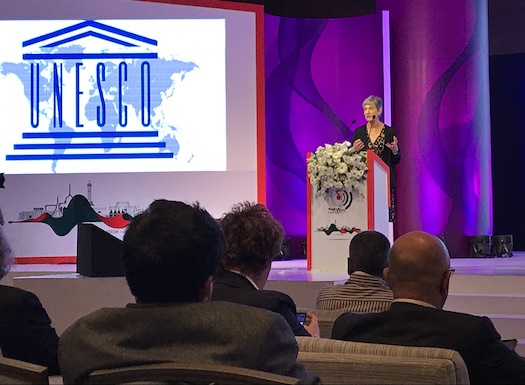Media literacy has become very important, not just for broadcasters but also for their audiences.
Karen Merkel from the UK National Commission for UNESCO introduced a panel of speakers at the Radio Asia conference who tackled the topic of media literacy from various viewpoints.
“Very few people in the community were interested in media literacy in the past, but the world has turned.
“In global media and information literacy week I can tell you that media literacy has come out of the darkness and more people are interested now than just teachers and media makers.
“This is our industry, we have to take the initiative to lead in the area of media literacy.”
Why has media literacy become such a pressing issue now?
“For the past ten years we have been deluged by waves of fear from content that suddenly seemed to be everywhere. Problems such as protecting children from pornography, easy access to violent horrible extremist material, hate speech, propagandist disinformation known as fake news, and trolling.
“As an industry it is our task to reframe this situation,” she said.
UNESCO has developed a range of resources to help inform people more about media literacy. Click for resources: Overview, Teaching Curriculum, Media Literacy Week.
It is Global Media Information and Literacy week, a fitting time to be discussing this topic, according to Merkel
Bangladesh university professor Golam Rahman, one of the panel members said: “Fake news travels faster than real news due to the internet. People become the victims of that fake news, being misled and often panicked.”
Professor Kaberi Gayen believes Bangladesh is at the danger level for fake news. She presented several examples of fake news that has provoked riots, such as the Cox’s Bazaar riot responding to a fake post on Facebook that dishonoured the Prophet Mohammad. “In our country it is a big problem that affects peace and stability when thousands of people act on fake news.”
Why does this happen? There are a range of reasons according to Gayen:
- Impunity
- No media literacy, people can’t distinguish fake news
- No in depth reporting, too much soft news and simplified reporting, without going deeper to help people understand the news.
- More than 10,000 media portals without any regulation
- Huge proportion of illiterate users
- There is a digital security act, but no one is aware of it.
What can broadcasters do? “Broadcasters and journalists need to engage with their audiences to help them understand fake news,” says Gayen.
Sophia Hultqvist from the FOJO Media Institute, supports free independent professional journalists around the globe. She said:
“Fact checking is not new in journalism, it is what we do every day. But what is new is the ability for so many non journalists to get their views out on social media…
“We live in bubbles on the big digital platforms, we need specislised people to help us get out of these bubbles.
“At a time when media is under attack in so many ways… we need to explain why journalism is important in society… There is a difference between how professional journalists work and others who just post their opinions on social media.
“In Sweden if someone does an investigative piece everyone follows up and face checks it in their own media. If you get it wrong you are embarrassed, but in other countries this is not the case.”
France Media Monde’s John Maguire (pictured above) has noticed that in countries where there are younger and less educated people, that is where the biggest potential for fake news is.
“We are in the middle of a revolution, caused by artificial intelligence. Biotech and Infotech are being affected by deep fakes… The problem is, can you believe your eyes and ears any more?”
He gave various examples, including a video of the former Italian Prime Minister which was manipulated by technology to show him swearing. It caused a backlash against him in the community.
15,000 new deep fakes have gone online in the past year, according to Maguire.
“This is affecting countries with low literacy levels especially where there is high usage of WhatsApp. People feel that WhatsApp is safe because it is encrypted, but anyone can still distribute fake content on it.”
France Media Monde is tagging all its content on the internet with a metadata ID to help people determine if it is real.
No electoral systems anywhere in the world is capable of meeting this challenge. Opposition countries may try and disrupt elections by using deep fakes, according to Maguire.
Speaking after Maguire, the BBC’s Indu Shekhar Sinha gave a powerful example of deep fake technology.
The BBC used the technology on its newsreader Matthew Amroliwala to illustrate just what could be done. They gave him the gift of tongues, making him speak in three languages which he has never learned.
The A.I. powered editing system literally put words into his mouth that he had not spoken.
Matthew only speaks English, but by using artificial intelligence software he suddenly appears to be speaking Spanish, Mandarin and Hindi.
The technique uses software that replaces the original voice and mouth movements of the subject. The software, created by London based start-up Synthesia, mapped and manipulated Amroliwala’s lips to mouth the different languages. Amroliwala was asked to read a script and the same phrases were also read by speakers of other languages and inserted into his mouth.
There is no legislation to control deep fakes because the technology is so new.

